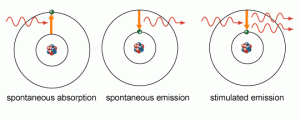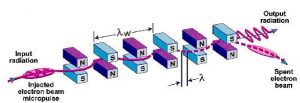The European XFEL, a powerful new scientific instrument based at Germany’s nuclear research institute DESY near Hamburg has produced its first light pulses. The light produced by the XFEL (which stands for X-ray Free Electron Laser) has a wavelength of 0.8 billionths of a meter, that’s about 500 times shorter than the wavelength of visible light.
Although the XFEL only produced a single pulse of light as a test of it’s performance, when it is fully operational in September the instrument will produce 27,000 pulses every second. Also, while the X-ray photons produced by the XFEL are only considered “soft” X-rays, with an individual photon energy of around 10,000eV, the intensity of the light, that is the number of photons produced will be greater than any other X-ray source on Earth.
The research planned for the XFEL includes taking photographic images of individual atoms, investigations into just what is going on during chemical reactions, especially bio-chemical reactions, and even studies of conditions existing in the interior of planets
Now a Free Electron Laser (FEL for short) is a very different kind of Laser from the Laser pointers or Gas Lasers people are more familiar with. I happen to know a lot about the differences because I wrote a paper describing those differences for my course in Quantum optics back in grad school. My professor for that course was Lorenzo Narducci, a well known and highly regarded researcher in Quantum Optics. Doctor Narducci adamantly insisted that those differences were such that Free Electron Lasers were not actually Lasers. Which of course begs the question; what is a Laser.
Many people know that the acronym Laser stands for Light Amplification by Stimulated Emission of Radiation and they know that a Laser’s light is special because it is a very narrowly focused beam of only a single frequency or colour. However, the way that a Laser produces that light isn’t commonly understood, so I’m gonna tell ya.

Looking at the picture above we can see how an atom in its ground state can absorb a photon of light at a certain wavelength (spontaneous absorption) becoming excited in the process. The atom will then emit that photon again at a later time (spontaneous emission).
Funny thing is though, if while the atom is excited by the first photon a second photon comes along similar to the first (same wavelength) the second photon can stimulate the atom to emit its stored photon (hence the Stimulated Emission in Laser) and the two photons will fly off in the same direction together in step with each other, this is called coherence.
Do this with a lot of atoms all at once (something known as a population inversion) and you get the powerful flood of coherent light we call a Laser. It’s kind of like the difference between a lot of people just walking around and an army of men marching in step. A Laser is more powerful just as the army is more powerful.
Now a Free Electron Laser produces its light by a completely different mechanism. A beam of electrons is accelerated to close to the speed of light. This is usually done using what is known as a Linear Particle Accelerator and the Linear Accelerator at DESY for their FEL is 3.4 kilometers in length.
This beam of high energy electrons is then directed through the center of a device called an undulator where thousands of permanent magnets are arranged with alternating magnetic poles, north-south then south-north back to north-south then south-north and on and on. See picture below.

The charge on the electrons in the beam interacts with the magnets causing the electrons to undulate back and forth, switching direction every time the poles of the magnets flip and this switching back and forth produces a high intensity beam of light whose wavelength is determined by the spacing of the magnets and the velocity of the electron beam.
Now the light from a FEL does have several characteristics in common with the light from a Laser, the output beam is both very narrowly focused and the photons produced are almost exactly the same wavelength. However the light is certainly not produced by Stimulated Emission of Radiation, which is why Professor Narducci refused to consider FELs to be true Lasers.
Whether or not you decide that Free Electron Lasers are real Lasers the world will soon have powerful new instrument for the study of the interaction of matter and light. I look forward to the results that will come from the European FEL. By the way Professor Narducci gave me an A in quantum Optics!
